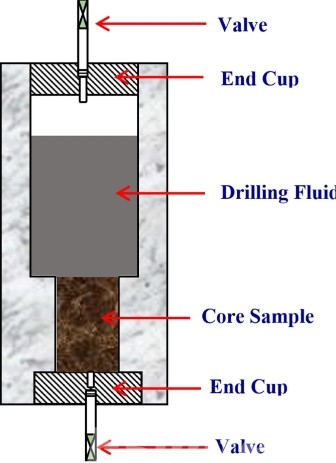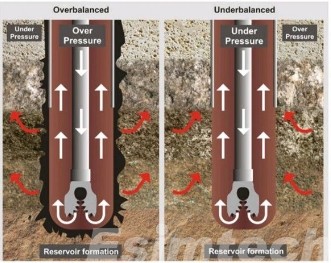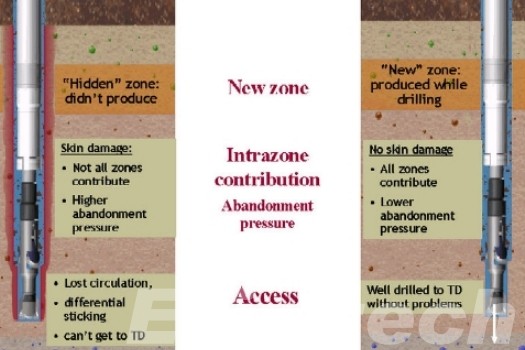What Do You Know about Overbalanced Drilling
Overbalanced drilling is a conventional method used in the oil and gas industry to ensure that the pressure of the drilling fluid in the wellbore exceeds the pressure of the surrounding formation. This approach is designed to prevent the uncontrolled flow of formation fluids into the wellbore.

Key Concepts of Overbalanced Drilling
The key concepts underpin the reliability and common use of overbalanced drilling in conventional oil and gas operations.
- Hydrostatic Pressure: Central to overbalanced drilling is maintaining the drilling fluid’s hydrostatic pressure above the formation pressure. This helps prevent the formation of fluids, such as oil, gas, or water, from entering the wellbore.
- Drilling Fluid (Mud) Properties: The drilling fluid’s density and composition are carefully adjusted to ensure it exerts sufficient pressure. This fluid serves as a barrier that stabilizes the wellbore and transports cuttings to the surface.
- Well Control: Overbalanced drilling inherently provides a layer of well control by preventing unexpected influxes of formation fluids (kicks) that could lead to a blowout.
- Formation Stability: The pressure exerted by the drilling fluid helps maintain the integrity of the borehole walls, reducing the risk of wellbore collapse or sloughing.
- Pressure Management: Accurate pressure control is crucial. Operators monitor and adjust the drilling fluid’s pressure in real time to maintain a balance that prevents complications, such as lost circulation.
- Safety Margin: Overbalanced drilling typically includes a safety margin to ensure that even if pressure fluctuations occur, formation fluids will not breach into the wellbore. This margin minimizes operational risks and supports safe drilling practices.

Advantages of Overbalanced Drilling
- Enhanced Well Control: The primary advantage is the prevention of formation fluids from entering the wellbore, reducing the risk of dangerous situations such as kicks and blowouts. This safety factor is crucial in maintaining operational control.
- Borehole Stability: The higher hydrostatic pressure of the drilling fluid helps support the formation walls, minimizing the risk of wellbore collapse and maintaining structural stability throughout the drilling process.
- Effective Cuttings Transport: Overbalanced drilling ensures that the drilling fluid has enough pressure to carry cuttings from the bottom of the well to the surface efficiently, promoting a cleaner wellbore and continuous drilling without interruptions.
- Prevention of Formation Fluid Entry: By maintaining higher pressure in the wellbore compared to the formation pressure, overbalanced drilling acts as a barrier to stop formation fluids, such as water, oil, or gas, from seeping into the well.
- Operational Simplicity: Compared to more complex techniques like managed pressure drilling or underbalanced drilling, overbalanced drilling is straightforward in terms of design and execution. It remains the standard for conventional well operations due to its reliability.
- Adaptability to Various Conditions: Overbalanced drilling can be adjusted for different well depths and formations, making it a versatile choice for a wide range of drilling environments where the formation pressure is predictable.

Comparisons among Overbalanced Drilling, Underbalanced Drilling and Managed Pressure Drilling
This chart outlines the main similarities and differences among the three drilling techniques, illustrating their respective strengths, challenges, and typical applications.
| Aspect | Overbalanced Drilling | Underbalanced Drilling | Managed Pressure Drilling (MPD) |
| Definition | Drilling with hydrostatic pressure greater than formation pressure. | Drilling with hydrostatic pressure less than formation pressure. | Drilling with controlled pressure to match or slightly exceed formation pressure. |
| Well Control | Strong well control; prevents formation fluids from entering wellbore. | Higher risk of formation fluid influx; increased blowout risk. | Precise pressure control minimizes risks while managing influx. |
| Formation Damage | High risk due to mud infiltration into the formation. | Lower risk; formation is less damaged as pressure is below formation level. | Reduced risk compared to overbalanced; better control of formation damage. |
| Applications | Commonly used in conventional wells with predictable pressures. | Used when minimizing formation damage is critical. | Suitable for complex wells, high-pressure zones, or narrow margins. |
| Cuttings Transport | Efficient removal of cuttings to the surface. | Potential challenges due to lower pressure. | Good cuttings transport with controlled pressure. |
| Lost Circulation Risk | Moderate to high risk, especially if pressure exceeds formation strength. | Low risk as pressure is less than formation strength. | Managed to minimize loss with fine-tuned pressure control. |
| Complexity | Relatively straightforward with simpler equipment needs. | More complex; and requires specialized equipment to handle formation fluids. | High complexity; requires advanced equipment and monitoring. |
| Safety | High safety margin due to strong well control. | Lower safety margin; increased risk of blowouts and kicks. | Improved safety with dynamic pressure management. |
| Cost | Generally lower; widely used and understood methods. | Potentially higher due to specialized equipment and risk mitigation. | Higher initial costs due to advanced equipment can reduce overall drilling costs by preventing issues. |
| Operational Speed | Moderate; standard in conventional drilling operations. | Can be faster if formation entry is managed properly. | Can be slower due to the complexity of monitoring and adjustments. |

Best Practices for Overbalanced Drilling Operations
1. Optimized Drilling Fluid Management
- Accurate Mud Weight: Ensure the drilling fluid is properly weighted to maintain the correct pressure balance. Too high a weight can lead to lost circulation, while too low a weight risks formation fluid influx.
- Composition and Properties: Use drilling fluids that are specifically formulated to minimize formation damage while providing the necessary pressure to support wellbore stability.
2. Continuous Pressure Monitoring
- Real-Time Data Collection: Use advanced sensors and monitoring equipment to track downhole pressure and fluid levels in real-time. This helps detect any changes quickly and make necessary adjustments.
- Automated Systems: Implement automated drilling systems that can react to sudden pressure changes to prevent potential issues like kicks or blowouts.
3. Preventative Measures for Lost Circulation
- Proper Mud Conditioning: Regularly condition the drilling fluid to reduce the chances of losing circulation. Use lost circulation materials (LCM) if needed to plug fractures and prevent mud from escaping into the formation.
- Preemptive Treatments: Plan for potential lost circulation zones and have mitigation strategies ready, such as adjusting mud properties or deploying LCM quickly.

4. Avoiding Differential Sticking
- Drill String Management: Maintain consistent movement of the drill string to reduce the chances of differential sticking, especially in highly permeable zones.
- Pressure Control: Ensure the annular pressure difference is not excessive, as this can press the drill string against the formation wall.
5. Effective Hole Cleaning
- Maintain Proper Flow Rates: Ensure that the flow rate of the drilling fluid is sufficient to carry cuttings out of the hole and avoid blockages.
- Regular Monitoring: Check for signs of poor hole cleaning, such as cuttings buildup or high torque and drag on the drill string.
6. Contingency Planning
- Emergency Procedures: Develop and regularly rehearse a detailed plan for handling unexpected kicks, blowouts, or significant formation fluid entry.
- Equipment Readiness: Keep blowout preventers (BOPs) and other well control equipment in top condition and ready for immediate deployment.

Challenges and Mitigation Strategies in Overbalanced Drilling Operations
This chart provides a comprehensive overview of the main challenges associated with overbalanced drilling operations and outlines strategies to mitigate these issues.
| Challenge | Description | Impact | Mitigation Strategies |
| Lost Circulation | When drilling fluid is lost to the formation due to high pressure exceeding the fracture gradient. | Delays, increased costs, potential well control issues. | Use of lost circulation materials (LCMs), careful monitoring of pressure. |
| Differential Sticking | Drill string becomes stuck against the formation wall due to pressure differentials. | Delays, costly fishing operations. | Consistent drill string movement, maintaining balanced pressure levels. |
| Formation Damage | Invasion of drilling fluids into the formation, reducing permeability. | Reduced hydrocarbon flow rates, and long-term reservoir damage. | Use minimally invasive drilling fluids, seal formation pores effectively. |
| Wellbore Stability Issues | Difficulty maintaining wellbore stability in complex or fractured formations. | Wellbore collapse, stuck pipe, operational interruptions. | Proper mud weight adjustments, and real-time wellbore monitoring. |
| Pressure Management Complexity | Maintaining safe overbalanced pressure levels. | Risk of formation influx (kicks) or fluid losses. | Advanced sensors, real-time data integration, use of real-time drilling simulation tools. |
| Increased Cost | High costs due to specialized equipment, fluids, and contingencies. | Escalated overall project costs. | Effective pre-planning, and optimized resource allocation. |
| Environmental Risks | Fluid loss impacts water-bearing formations or ecosystems. | Regulatory issues, potential fines, environmental damage. | Best practices for containment, environmentally friendly additives. |
| Real-Time Data Dependency | Reliance on continuous data for pressure and fluid management. | Hindered decision-making in case of equipment or transmission failures. | Backup data systems, and redundant monitoring tools. |
| Complex Wellbore Paths | Drilling extended-reach or highly deviated wells. | Difficulty maintaining stability and pressure. | Advanced planning, high-tech simulation tools modeling for stress points. |

Overall, while overbalanced drilling is effective and well-understood, it requires careful planning and execution to manage the risks and challenges it presents.
